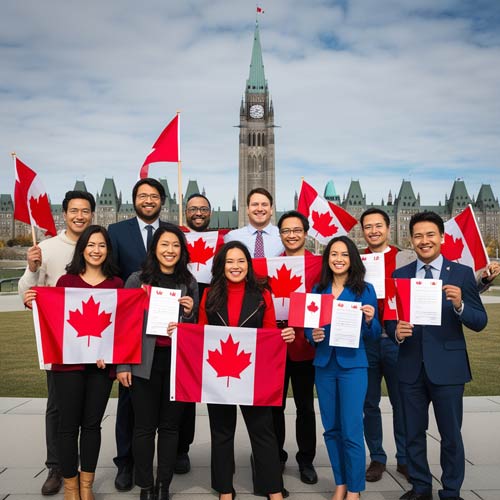Table of Contents
Canada Revamps Immigration Policies: Strengthening Temporary Residency and Pathways to Permanent Status
Canada is advancing its immigration policies to improve Temporary Resident Programs and pave clear pathways for migrants seeking temporary or permanent residency. These reforms aim to address labor shortages, attract skilled talent, and make the system more accessible and equitable. Enhancements include streamlined application processes, faster decision-making, and better protections for workers and students.
Temporary residents, such as skilled workers, international students, and visitors, play a vital role in Canada’s economy, filling critical gaps across industries like healthcare, agriculture, and technology. Recent initiatives also emphasize bridging temporary residency and permanent status through refined programs like the Canadian Experience Class and Provincial Nominee Programs. Additionally, special attention is being given to underrepresented rural and remote communities through initiatives like the Rural and Northern Immigration Pilot.
Key sectors such as healthcare, skilled trades, and agriculture will benefit from updates to the Temporary Foreign Worker Program and the International Mobility Program, making immigration more responsive to labor market demands while safeguarding worker rights. International students, a cornerstone of Canada’s immigration strategy, will see expanded work opportunities and improved pathways to permanent residency, further positioning Canada as a global education hub.
Transparency and digital innovation underpin these advancements, with user-friendly platforms ensuring efficiency and clarity for applicants. As Canada enhances its immigration framework, it reaffirms its commitment to economic growth, inclusivity, and global talent retention—cementing its role as a leader in modern migration policies.
Strengthening Canada’s Temporary Resident Programs and Migration Pathways: A New Era in Immigration Policy
Canada continues to shape its immigration landscape with proactive policies aimed at refining the Temporary Resident Programs and creating sustainable migration pathways. Recent statements from key government officials have highlighted the efforts underway to build a more efficient and equitable immigration system aligned with the country’s economic and social goals. Aimed at attracting global talent, addressing labor market shortages, and enhancing accessibility for applicants, these changes hold immense promise for individuals and families looking to call Canada their temporary or permanent home.

Bolstering Temporary Resident Programs: A Renewed Blueprint
Canada’s Temporary Resident Programs are critical pillars of its immigration framework, offering pathways for skilled workers, students, and visitors to contribute to various sectors. In addressing the evolving demands of the post-pandemic economy, Canada has acknowledged the need to adapt its policies. As it stands, temporary residents play a significant role in Canada’s workforce, filling essential gaps in industries such as healthcare, construction, agriculture, and technology.
Authorities are focusing on rebalancing the programs to ensure faster processing times, greater transparency, and improved client services. For example, initiatives such as enhanced digital platforms have made the visa application process more accessible to prospective applicants around the globe. These improvements are particularly critical for businesses and employers in Canada that rely on a steady influx of skilled international workers to meet pressing industry needs.
Additionally, the government has reiterated its commitment to ensuring that temporary residents are treated fairly. Key protections and safeguards are being expanded to shield international workers and students from exploitation while offering them avenues to assert their rights. Fairness and equity remain the focal points of this renewed strategy, reflecting Canada’s broader commitment to uphold human rights and values.
Strengthening Pathways to Permanent Residency
One of the most transformative aspects of Canada’s immigration policies has been its strategic focus on creating bridges between temporary residency and permanent residency. Acknowledging the contributions of temporary foreign workers, international students, and visitors to Canada’s economic and social fabric, the government is refining programs to ensure smoother transitions to permanent residency.
Immigration authorities are actively exploring ways to streamline these pathways by introducing simplified criteria and leveraging program-specific draws to meet the unique needs of provinces and economic sectors. Programs such as the Canadian Experience Class, Provincial Nominee Programs (PNPs), and Family Sponsorships remain critical vehicles for candidates looking to transition from a temporary to permanent status.
In addition, Canada’s immigration policy overhaul also centers around inclusivity. Special attention is being given to rural and remote communities that may not traditionally benefit from immigration-driven growth. Migration programs such as the Rural and Northern Immigration Pilot (RNIP) have been flagged for expansion to attract a diverse pool of applicants ready to contribute to underserved regions.
At “Sohi Law Group,” our experienced immigration team recognizes the importance of guiding clients through these evolving pathways. We offer tailored legal support to individuals and families exploring their options for transitioning to permanent residency, ensuring a seamless process.
Tackling Labor Market Needs Through Immigration Reforms
Canada continues to face labor challenges in various key industries due to an aging population and labor market volatility. Temporary resident programs remain a valuable tool to tackle these shortages. Through new policies, the government aims to fill gaps in ambitious sectors—from healthcare and the skilled trades to agricultural production—by facilitating the entry and retention of global expertise.
Immigration programs designed to address employer needs are being enhanced. The Temporary Foreign Worker Program (TFWP) and the International Mobility Program (IMP) are also being refined to make them more responsive to Canada’s labor demands while simultaneously ensuring fair recruitment and protection practices for workers.
Employers and international workers have reason to take note of these updates. At “Sohi Law Group,” we specialize in helping Canadian businesses leverage the immigration system to address labor shortages. Our skilled legal professionals assist employers with creating robust applications that meet compliance standards, while ensuring employees are well-supported.

Enhancing International Student Contributions
International students occupy a special place in Canada’s immigration strategy, as they bring immense economic value and a wealth of innovation to Canadian universities and communities. Recently, authorities have taken steps to expand work opportunities for international students, placing emphasis on their ability to gain meaningful employment during and after their studies.
In particular, extension of work permits for eligible international graduates demonstrates Canada’s investment in retaining educated, talented individuals trained within the country. By building a clear bridge between their education and potential permanent residency opportunities, the government seeks to make Canada a destination of choice for the world’s brightest minds.
Lawyers at “Sohi Law Group” emphasize the importance of staying informed on post-graduation work permit rules and permanent residency options for international students. With expert guidance, students can navigate the complexities of immigration law to achieve their long-term goals efficiently.
Transparency and Technological Innovation: The Way Forward
As part of this reform journey, transparency and technological innovation remain two driving forces in improving client experiences. By building faster, more efficient, and client-centered digital tools, Canada’s immigration system is poised to offer smoother and more transparent interactions for prospective applicants.
From automated application updates to streamlined chat support, these technological upgrades represent significant improvements. Applicants can anticipate faster response times and clearer communication channels, eliminating much of the frustration previously associated with tracking application status.
At “Sohi Law Group,” we are adept at working within Canada’s evolving digital immigration system. Our team ensures every step of the process is streamlined for our clients, using the latest platforms to meet requirements accurately and efficiently.

Looking Ahead
Canada’s commitment to evolving its immigration system reflects its understanding of the country’s needs and future growth projections. With a clear vision toward improving temporary resident programs, expanding migration pathways, addressing labor market imbalances, and modernizing applications, the nation remains a leader in global immigration policies.
As immigration laws and programs continue to adapt to the rapidly changing world, “Sohi Law Group” stands ready to assist clients in seizing these opportunities. Whether you’re an international student, a skilled worker, or a Canadian employer in need of legal advice, our team of immigration experts is here to guide you through every stage of the process. Trust our expertise and personalized approach to meet your immigration needs with confidence.





No comment